Side Menu:
Captain E.J. Smith - Early Life
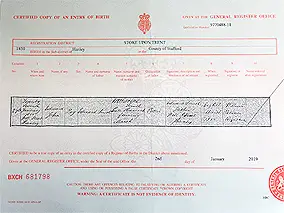
A copy of Smith's birth certificate.
(Click image to enlarge)
Many people assume that Edward "EJ" Smith, the legendary "Millionaire's Captain" had a wealthy upbringing so are perhaps surprised to learn that he was born to working class parents on Sunday, January 27th, 1850, in a poor, landlocked area of Staffordshire, England, in a small town called Hanley. His birth was later registered on the 8th March 1850
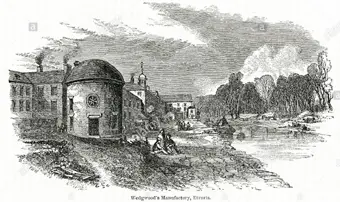
Etruria in 1857, a village near Stoke-on-Trent
built by Josiah Wedgwood to be the centre
of the Wedgwood pottery business.
The city of Stoke-on-Trent is made up of six separate towns - Tunstall, Burslem, Hanley, Stoke, Fenton, and Longton - collectively known as "The Potteries", due to its pottery industry. So it is perhaps unsurprising that his father, Edward Smith (1805–1885) was a potter, as was his grandfather. However, his mother, Catherine (formerly Hancock, née Marsh, 1809–1893), opened up a small grocery store in the front of the Smith house. Fortunately, this store, as well as a second property they owned, provided a decent income so that young Ted could avoid working in the pottery industry and look further afield.
Young Edward was generally referred to as Ted although later later nicknamed "E.J.". Catherine's son from a previous marriage, Joseph Hancock (1833–1893) was in the merchant navy when Edward was born. Ted also had a half-sister, Thyrza Hancock.
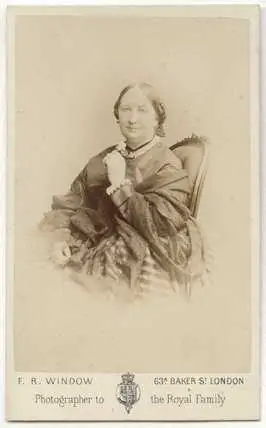
Edward Smith's mother - Catherine Hancock née Marsh
(Photograph: - Lucille Montgomery)
The Wrong House - Well Street
It is commonly accepted that Smith was born at no.51 Well Street, with a plaque installed on the wall. However, the reality is that Edward Smith's birth certificate does not record a house number and secondly the houses at no.51 were built in the 1880s or 90s and hence long after Smith was born.
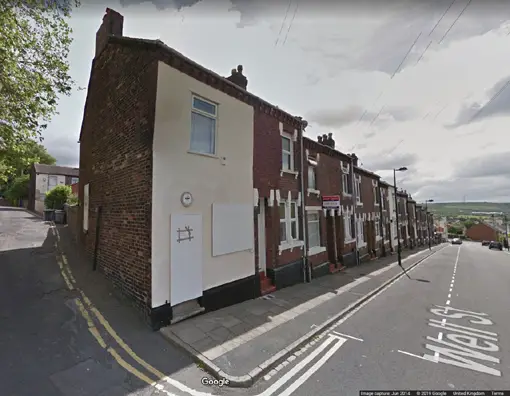
Present day view of Well Street and the no.51 corner house, incorrectly identified as Smith's birth place. (Credit: Google)
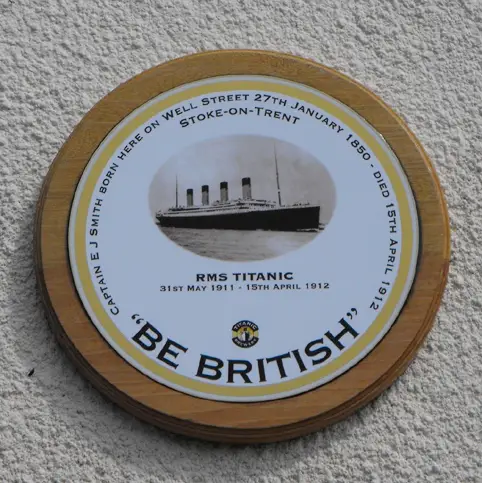
A close up of the plaque that is placed erroneously on the house at no. 51 Well Street. The actual house no longer exists.
(Click to enlarge)
The confusion is likely due to a misreading of the entry for the Smith family in the 1851 census (HO107 2004/139) when Smith was a one-year-old. No house number is indicated, however there is a number 51 written in the extreme left-hand column, which has likely been mistaken for a house number. But comparing other consensuses shows that the Smiths lived at numbers 86, 17 (in 1861) and 30 (in 1871) which is most likely the same house simply renumbered over the years. This can be deduced by the fact that despite the number changes, the names of the neighbours remained the same during this twenty-year period, and confirmed by number 17, being recorded in 1861 as a 'Grocer's Shop' (RG9 1932/7.)
The actual house was likely demolished by construction of the ring road in Hanley and so no longer exists.
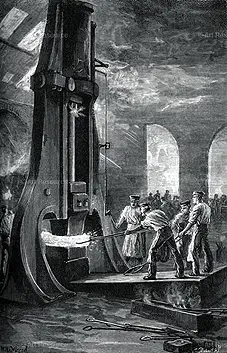
Smith's first job was operating a
Nasmyth's steam hammer, as seen
here during the 1880s (Roberts)
School and First Job
Smith attended the nearby mainstream Wesleyan Methodist school, the Etruria British School, established and maintained by Wedgwood Potteries and located within the confines of the Wesleyan chapel, His attendance cost three shillings per month. Edward was remembered by his classmates as "a quiet, respectable, courageous lad who never put himself to the front too much," but also a boy who did not shy away from a scrap. (The Man Who Sank the Titanic? The Life and Times of Captain Edward J Smith, by Gary Cooper, 1998). We gain a rare insight into the childhood of Edward Smith via one his classmates, a Mr William Jones, of Edmund street, Hanley, Stoke-on-Trent. Jones described recalling that 'Teddy was a genial and good schoolfellow, one always ready to give a kind of helping hand in any way to his mates' (Daily Sketch, 25 April 1912). The article also quoted Jones:
My memory brings back many happy days spent with him at school, and also many happy hours before and after school-time. There were six of us in those days - six firm friends who stuck together, and Smith was the staunchest of us all. I remember how Vincent Simpson used to call on me first, and how we would call for Johnny Leonard. Then the three of us would knock at Ted Smith's door, and having collected the others we would run down Mill-street and Etruria-road to school. (Daily Sketch, 25 April 1912).
The newspaper added that "one of Mr Jones' most treasured possessions is a faded photograph of the group of the six lads who went daily to Etruria school, in which the bright, determined face of the boy who was to be the leading figure in the world's greatest maritime disaster stands out conspicuously."(Daily Sketch, 25 April 1912).
He then obtained a job in 1865 at the Etruria Forge around the age of 15, operating a Nasmyth steam hammer. It might have looked as if his career as a local labourer in The Potteries was set, however, it was not to be thanks to a relative - his half-brother Joseph Hancock, who had moved to Liverpool and worked his way up to being a captain and had no doubt influenced the young Ted with tales of the sea during his visits to the family.